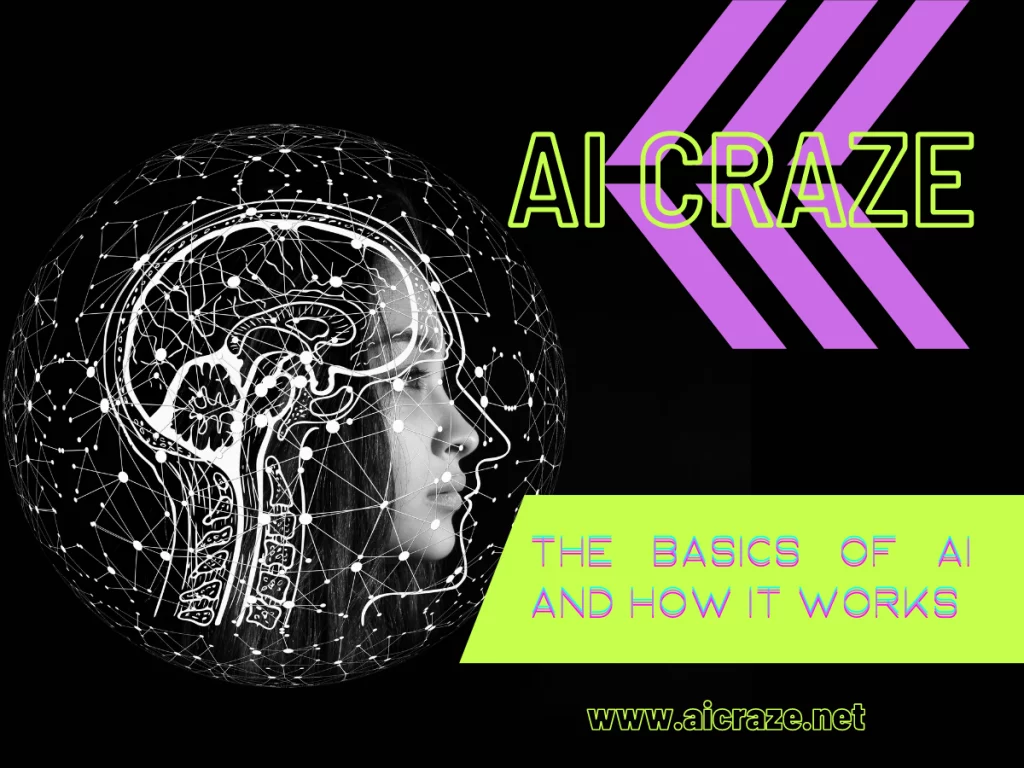
Artificial intelligence, or AI, is a rapidly developing technology that is revolutionizing many industries. It has the potential to make our lives easier and more efficient in countless ways, but for many people, the concept of AI is still shrouded in mystery. In this article, we’ll explain the basics of AI and how it works.
What is AI?
To learn the basics of AI, we should know what is AI. At its core, AI is a computer program that is designed to mimic human intelligence. This can include everything from speech recognition and decision-making to pattern recognition and language translation. AI can be divided into two main categories: narrow or weak AI, and general or strong AI.
Narrow AI is designed to perform a specific task, such as facial recognition or language translation. These programs are typically very good at their specific task, but they are not capable of doing anything else. General AI, on the other hand, is designed to be as versatile as a human brain. It can learn and adapt to new situations, solve problems, and make decisions based on context. After learning about what is AI, the next step for learning the basics of AI is to know how AI work.
How Does AI Work
At its core, AI works by processing large amounts of data and using algorithms to identify patterns and make predictions. The process involves three main steps: data input, processing, and output. Let’s take a closer look at each of these steps because these are the steps to learning the basics of AI.
- Data Input:
The first step in the AI process is data input, which involves collecting a vast amount of data from various sources such as sensors, cameras, microphones, and other devices. For example, an autonomous car might collect data on traffic patterns, road conditions, and weather conditions using a combination of sensors and cameras. A speech recognition system might collect data on people’s speech patterns using microphones.
The quality and quantity of data are critical to the success of an AI system. The more data an AI system has to work with, the better its predictions become. However, the data must also be relevant and accurate, or the AI system may make incorrect predictions. This step is also included in the basics of AI.
- Processing:
The second step in the AI process is processing, where the data is analyzed using various algorithms to identify patterns and make predictions. These algorithms can be trained using machine learning techniques to improve their accuracy over time. There are various types of machine learning, such as supervised learning, unsupervised learning, and reinforcement learning.
Supervised learning involves using labeled data to train an AI system to make predictions. For example, an AI system might be trained to recognize cats in images by being shown thousands of labeled images of cats and non-cats. Unsupervised learning involves finding patterns in unlabeled data, where the AI system is not given any information about the correct answers. Reinforcement learning involves training an AI system by rewarding it for correct actions and punishing it for incorrect actions.
The algorithms used in AI systems are often based on neural networks, which are modeled after the structure of the human brain. Neural networks consist of layers of interconnected nodes, with each node processing a small amount of data and passing it on to the next layer. The output of the final layer of nodes is the AI system’s prediction. This is another step you should know to learn the basics of AI.
- Output:
The final step in the AI process is output, where the AI program takes action based on its predictions. For example, an AI program could recommend a product to a customer, control the temperature in a room, or adjust the speed of a self-driving car based on traffic conditions.
AI applications can be divided into two categories, namely, narrow and general AI. Narrow AI, also referred to as weak AI, is purposely developed to perform specific tasks within a limited scope, such as speech recognition or image classification. On the other hand, general AI, also known as strong AI. It is created to execute any cognitive task that a human can accomplish.
In order to be effective, AI requires a large amount of data to be able to learn and make accurate predictions. This is why many companies are investing heavily in collecting and analyzing data in order to develop more powerful AI systems.
In general, the operation of AI is based on the analysis of massive data sets utilizing intricate algorithms to detect patterns and make prognoses. With the ongoing advancement of this technology, we anticipate the emergence of more complex and potent AI systems. Which can address a diverse array of intricate issues.
AI examples in real life
Artificial Intelligence (AI) is already transforming many areas of our lives, from healthcare and finance to transportation and entertainment. Here are some of the most prominent AI examples in real life.
- Healthcare:
Doctors use AI in healthcare to analyze patient data and make diagnoses. For example, IBM’s Watson for Oncology uses natural language processing and machine learning to help doctors make treatment recommendations for cancer patients. AI is also being used to develop personalized treatment plans and predict which patients are at risk for certain diseases. This is the most important AI example in real life.
Also Read: Artificial Intelligence In Medicine
- Finance:
People use AI in finance to analyze market trends and make investment decisions. For example, BlackRock uses AI to analyze data from social media and news sources to make investment decisions. AI is also being used to detect fraud and reduce the risk of financial losses.
- Transportation:
Automobile manufacturers use AI in transportation to improve safety and efficiency. Self-driving cars are a prime example of AI in transportation, with companies like Tesla and Google developing autonomous vehicle technology. Governments use AI in air traffic control to optimize flight paths and reduce congestion. This is the most common AI example in real life.
- Retail:
The utilization of AI in retail is geared towards enhancing the shopping experience and boosting sales. For instance, Amazon employs AI to provide customers with personalized product recommendations based on their past browsing and purchasing behavior. Additionally, people also use AI to scrutinize customer data, identify patterns, and create targeted marketing strategies.
Also Read: AI In E-commerce
- Entertainment:
People from the entertainment industry use AI in entertainment to create more engaging and personalized experiences for consumers. For example, Netflix uses AI to recommend movies and TV shows to users based on their viewing history. Creators also use AI in video games to create more realistic and immersive experiences.
- Education:
Institutions are applying AI in the field of education to tailor learning to individual students and enhance academic performance. An instance of this is the use of AI by Carnegie Learning to deliver customized mathematics tutoring to students. Institutions are also using AI to analyze student data to identify areas where students need additional support. This is the most important and beneficial AI example in real life.
- Manufacturing:
The application of AI in manufacturing aims to increase efficiency and reduce expenses. As an example, General Electric employs AI to scrutinize data obtained from sensors fitted on its machinery to predict when it requires maintenance. Moreover, they are also using AI to optimize production processes and minimize waste.
These are merely a few examples of the practical implementation of AI. As technology advances, we can anticipate the emergence of even more ingenious applications across various industries.
what is the future of AI
The future of AI is both exciting and uncertain. While AI has already made significant advances in a variety of industries, there is still much to be discovered and developed. So, we will try to explore what is the future of AI.
One of the most promising areas of AI research is the development of more advanced deep learning algorithms. These algorithms are designed to mimic the way the human brain processes information, and they have the potential to revolutionize the way we approach complex problems.
Another area of focus is the development of AI-powered robotics. This technology holds the potential to automate numerous jobs presently performed by humans, potentially resulting in noteworthy improvements in efficiency and productivity. However, it also raises concerns about job displacement and the need for retraining workers for new roles.
In addition to these technological advances, there are also important ethical considerations to be addressed. For example, there are apprehensions regarding the potential misuse of AI for malevolent intentions, such as carrying out cyberattacks or developing autonomous weaponry.
Despite these challenges, many experts believe that the future of AI is bright. As AI continues to evolve, it has the potential to revolutionize a wide range of industries, from healthcare and transportation to finance and entertainment.
One of the most exciting possibilities is the development of AI-powered virtual assistants that can help us with a variety of tasks, from scheduling appointments to making travel arrangements. These virtual assistants could also be used to help us navigate complex information environments, such as online shopping or social media.
Overall, the future of AI is both exciting and uncertain. As researchers continue to make breakthroughs in AI technology, we can expect to see new and innovative applications in a wide range of industries. However, it is important to remain vigilant and address ethical and societal concerns as we move forward.

